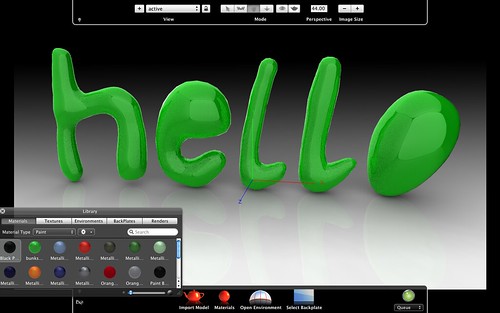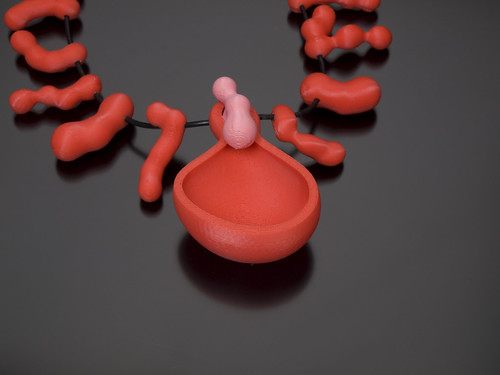
Hypershot 2010 in fullscreen mode with some quick SmoothTeddy models
Today, one of our students was talking about the future in Thesis class. He was contemplating a body of work that embraces the rapid changes in the world; but was unsure about taking on an optimistic point of view because he really didn't believe it. Well, in at least one respect, I am looking forward to the future. Not a future of increasingly sophisticated and complicated systems, where only those of us who are willing and able to memorize and control complicated workflows can create. I am looking forward to the generations of software and hardware that we can understand by playing with them, where there are results between technical success and failure. Naked edges in NURBS, incompatible filetypes, out of gamut colors, drivers that won't install...I think this stuff is dying. Designers are increasingly capable of giving us studio tools that barely even need to be taught as technical subjects in college courses. What's my evidence? For now, Hypershot.
When I started 3D modeling, less than 10 years ago, the modeling process was complicated enough - generating anything approaching photo-realistic renderings was pretty much rocket science to me. 3D Studio Max has about 100 dialog boxes with sub boxes within sub boxes - it's super powerful and too difficult to learn and has way more features than a designer would EVER use. Flamingo was awesome and fairly straight forward - but was still more difficult to setup than a photography studio to take pictures of physical work. When an auto designer at GM introduced me to Hypershot my first words were "this is how rendering should work." I took existing data that I had created with significant labor, and used Hypershot's virtual camera to take pictures of it in views and materials that were realistic and compelling. This software DSLR is faster, has more flexibility, and can shoot in dynamic points of view that my Olympus Evolt 500 could get into only if I fitted it with a robotic tripod arm and a lens with infinite depth of field. And I was realistically rendering within minutes of getting the model into rough shape. I could confidently 'digitally prototype' my design well before the piece was "watertight;" making decisions about whether or not something was right before I even finished the form, before I hit "print" on any of our 3D printers, before I went through the 20 hours of finishing one of my castings.

The new render queue in Hypershot '10, visual, simple, it persists even if you have to close it out, crashes etc.
The key advantages, to me, of Hypershot include: it is always rendering in real time. As soon as you move your viewport, it starts casting shadows, reflections, etc. There are NO LIGHTS. You get dynamic light from an environment map which not only illuminates, but provides the reflections to accentuate your form (and you switch between them at will to change the mood of the image). There is no visible horizon to worry about accidentally seeing in the frame. If you are looking, like me, for some kind of neutral infinity background, it uses any .jpg or .tiff image as a 'backplate' behind your rendering to cover the environment/ground behind the model. And there are few complicated choices to make in the selection of materials and output etc. You drag and drop, slide qualities up and down, choose between few standard formats for the image.
Recently I started beta testing the '10 version of Hypershot. And its ease of use, professional power, visual simplicity, and available customization is an example I wish more companies would follow. It has gotten more sophisticated, there are more options. But they were designed in such a way that they are fairly intuitive, they don't obscure the process of image making - they clearly facilitate it. When I demo this software for my students tomorrow, it will be with an awareness that my traditional role as vessel of technical knowledge is fast becoming obsolete. I am looking forward to this future - when I can concentrate on helping them with their bigger problems; like becoming effective designers - not mechanics. My role as chief know it all is all but over, right when I was about to run out of steam staying two steps ahead of them on the latest version of software...
Recently I started beta testing the '10 version of Hypershot. And its ease of use, professional power, visual simplicity, and available customization is an example I wish more companies would follow. It has gotten more sophisticated, there are more options. But they were designed in such a way that they are fairly intuitive, they don't obscure the process of image making - they clearly facilitate it. When I demo this software for my students tomorrow, it will be with an awareness that my traditional role as vessel of technical knowledge is fast becoming obsolete. I am looking forward to this future - when I can concentrate on helping them with their bigger problems; like becoming effective designers - not mechanics. My role as chief know it all is all but over, right when I was about to run out of steam staying two steps ahead of them on the latest version of software...
Hypershot '10 is the '64 Mustang, Chester Carlson's photocopier, the first Macintosh. One of those things you didn't know you needed or wanted until someone put this beautiful, simple, game changing widget in front of you and said "hello," I love you. Now, if we could just work on getting the price down, you could all see what I mean.












